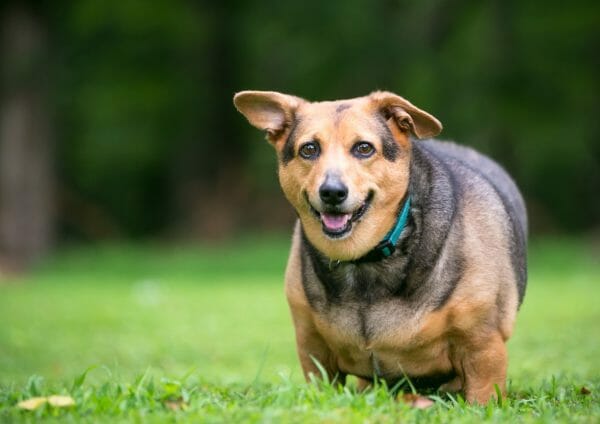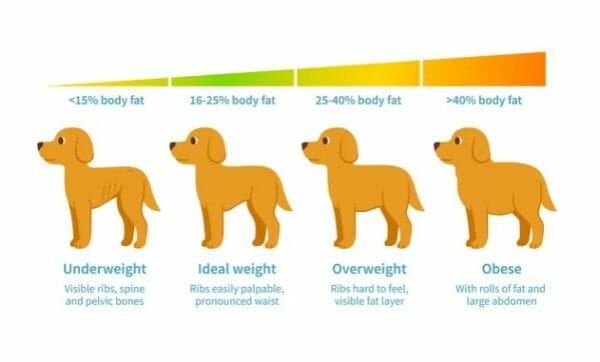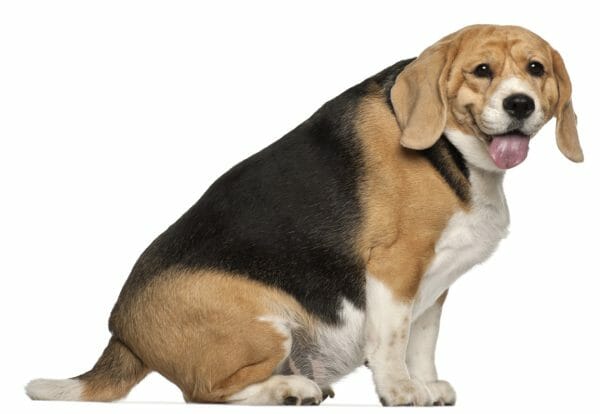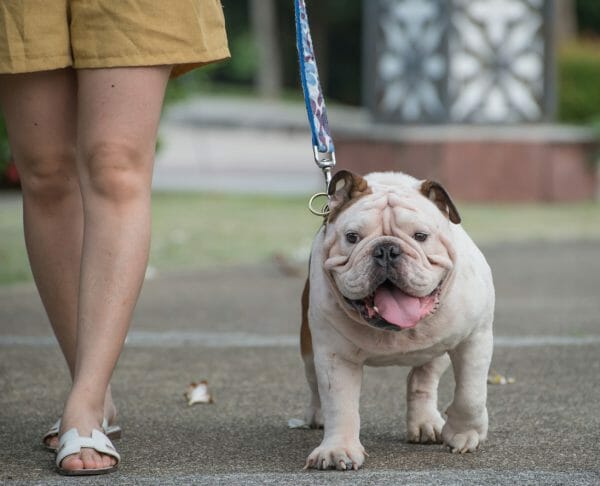Dog Obesity Statistics
A 2018 survey conducted by the Association for Pet Obesity Prevention found that overweight or obese dogs comprised approximately 56% of the canine population in the United States. That equates to 50 million overweight dogs. The growing problem of obesity in dogs and cats is putting the health of pets in jeopardy.
The same survey found that the top priority for pet owners when sourcing dog food was its country of origin and production, whereas the lowest priorities were whether the food was low-glycemic or had portion control packaging.
It will probably come as no surprise that obesity ranks as the most prevalent preventable disease affecting dogs today. Severely obese dogs are in the high-risk category for a wide range of serious health conditions. Unless steps are taken to reduce a dog’s weight, obesity could lead to early death.

What Is Obesity in Dogs?
Obesity occurs when excess body fat is accumulated. There is generally a strong link between additional body weight and excess body fat. If a dog is overweight, there is a strong likelihood that it has excess body fat. It is important to identify where a dog sits on a dog obesity scale so that appropriate steps can be taken to manage its weight.
The simplest way of assessing whether a dog is overweight or obese is to measure body weight. This is because measuring body fat can be more challenging. If a canine weighs up to 20% over its ideal weight, it is overweight. When a canine is more that 20% above its ideal body weight, it is considered obese.
It is important to remember that the ideal body weight for each dog will be based on its breed and overall size. This means that larger breeds of dogs (such as a Cane Corso or Newfoundland) will have a higher ideal body weight than a smaller breed of dog (such as a Yorkshire Terrier or Jack Russell Terrier).
Dog Obesity Chart and Body Condition Score
Because many dogs are overweight, it is difficult to know what a healthy example of a breed should look like. Owners should acquaint themselves with a dog obesity chart and conduct research into the ideal weight for their dog’s breed. A simple dog obesity chart is provided below.

Most veterinary practices use a body condition scoring system, which provides numerical rankings from 1 to 9. Dogs rated a 1 through 3 are below their ideal weight. Dogs rated a 4 or 5 are at their ideal weight. Dogs rated from 7 to 9 are overweight or obese. Each number is accompanied by a description for assessing a dog’s weight.
For example, in a severely underweight dog (score of 1), the bones are prominent and easy to see, there is no discernible body fat, and there is an obvious loss of muscle mass. By contrast, a dog scored as a 9 (massively obese) has massive fat deposits throughout its body, the waist and abdominal tuck are absent, and there is obvious abdominal distention.
A score of 4 or 5 (ideal) means a dog’s ribs can be easily felt and have minimal fat covering and the waist and abdominal tuck can be easily observed.
A veterinarian will be able to provide advice on typical breed weights. Feeling the dog’s ribs and shoulder blades is a good way of checking for signs of obesity between weigh-ins and veterinary check-ups. In addition, Royal Canin provides an online Body Condition Score tool for dogs and cats that allows owners to enter their dog’s breed to get detailed information on the expectations for their ideal weight and appearance.
Obese Dog Symptoms
Symptoms of obesity in dogs are:
- Not being able to see or feel the dog’s ribs, waistline, or spine
- Sagging around the abdomen
- Reluctance to go out for a walk
- Tiredness and excessive panting
- Requiring assistance getting into the car or onto furniture
- Lethargy
- Lack of interest in playing games
- A rounder face

Causes of Obesity in Dogs
Any unused energy is stored in the dog’s body as fat. There are several contributing factors that can lead to canine obesity, including:
- Quality and quantity of diet provided by the owner
- Age of the dog
- Sex
- Whether the dog has been neutered
- Level of activity and exercise
- Any underlying conditions impairing exercise
Some dog breeds have a disposition towards obesity, and genetics may have an effect too. Typically, adult dogs that have been neutered will often weigh more than unneutered. When a dog is given human food, this can bring on excessive weight gain. This can be a particularly big problem in toy breeds.
Which Breeds Are Most Susceptible to Obesity?
There are several breeds that have a high propensity for developing obesity:
- Pugs
- Bulldogs
- Labrador Retrievers
- Basset Hounds
- Beagles
- Dachshunds
Owners of these breeds need to be conscious that adequate exercise and a good balanced diet is provided.

Obese Dog Health Problems
It was once thought that fatty tissue was just a way to store energy and insulate the body. More is now known about the dangers of obesity in dogs. For example, fat secretes hormones that can cause inflammation, affect appetite, alter sensitivity to insulin, influence water balance, and bring about high blood pressure and kidney disease.
Obesity in dogs’ health risks also include:
- Diabetes mellitus
- Hypertension
- Heart disease
- Osteoarthritis
- Degeneration of joints
- Bladder stones
- Several types of cancer
- Problems breathing brought about by laryngeal or windpipe collapse
- Breathing problems in brachycephalic breeds (such as Pugs)
- Lowered life expectancy
Prevention of Obesity in Dogs
Preventing obesity should start the day any owner takes in a new dog. There are a few ways this can be done:
- Controlling portion sizes
- Using interactive feeding toys
- Providing consistent mealtimes
- Using appropriate dog food
- Not feeding scraps of human food from the table
- Ensuring plenty of exercise

How to Treat Obesity in Dogs
If a dog is overweight or obese, it will be necessary to take steps to help reduce its weight. Obesity in dogs’ treatment should include improvements in diet and an increase in exercise.
Simply reducing the dog’s current food intake is not appropriate as it could lead to malnourishment. Therefore, before changing a dog’s diet, consult with a veterinarian as there are several scientifically formulated obesity management dog food products to help with safe and healthy weight reduction. Many of these products will require a prescription.
Some examples of the best dog food for obese dogs include:
- Purina Pro Plan Veterinary Diets OM Overweight Management Diets
- Royal Canin Veterinary Diet Adult Satiety Support Weight Management Dog Food
- Hill’s Prescription Diet r/d Weight Reduction Dry Dog Food
Following an obese dog diet plan will involve ensuring the calorie density is decreased while maintaining the appropriate balance of nutrients. New food should be introduced gradually over the course of a week.
Once portion size is determined, it will be important to maintain this as well as the frequency and timings of meals. Treats should not account for more than 10% of the daily calorie intake for a dog. Appropriate snacks could include fresh beans, cauliflower, and broccoli.
An obese dog exercise plan can also help with weight loss. Before embarking on a new fitness routine, speak to a veterinarian to ensure there are no underlying conditions that might impede activity such as arthritis or heart disease. Begin with 15 to 20 minutes of leash walking each day, and gradually build up the length and intensity of the exercise as the dog starts to lose weight.



